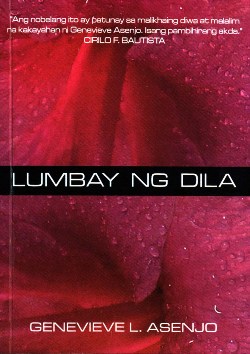FRENCH feminist critic Helen Cixous, in her essay “The Laugh of the Medusa," bravely stipulates that “the woman writer should write her self" if she wants to “reclaim her voice" and “reclaim her body that was confiscated by patriarchal society." This confiscation leads to women being subordinate to men that they cannot even enjoy their own bodies, literally and figuratively. If only Cixous could read a novel in Filipino (Visayan-laced Filipino, to be specific), she might enjoy intellectual ecstasy in reading the latest book of Genevieve L. Asenjo, a novel called
Lumbay ng Dila (Loneliness of the Tongue). Set in the bucolic province of Antique and chaotic Taft Avenue in Manila, this is the story of a young literature teacher in a university, Sadyah Lopez. She is looking for herself in the city and also looking for her long-lost mother, Teresa, a former commander of the New People’s Army in Panay who is now an NGO worker. Sadyah’s name is from the Kinaray-a word
“sadya" which means “happy." Kinaray-a is the language in Antique and is the dominant language in Panay, being the mother language of the more well-known Hiligaynon (often mistakenly called “Ilonggo" which actually refers to a person from Iloilo province) spoken in the cities of Iloilo, Roxas in Capiz, and Bacolod in Negros Occidental. Asenjo incorporated Kinaray-a and Hiligaynon words in the writing of her novel, a practice introduced by Palanca Hall of Famer Leoncio P. Deriada in Iloilo which he describes as “Visayan-laced Filipino." For what is Filipino, the national language, but the happy mixing of all existing Philippine languages and colonial languages? Filipino is still in its process of development, and what Asenjo has done is to quicken the process of language formation, or “language engineering" as Deriada would put it. Sadyah probably did not have a happy childhood. She was left by her parents in the care of her aunt, as her father and mother used to be active NPA leaders. Her father was killed in an ambush along with Sadyah’s baby brother Dakila. She only found out about her dead brother towards the end of the novel, when she and her mother were talking in Sadyah’s condominium unit near Taft Avenue. Thanks to the Internet they finally met —one hot mama and one hot daughter. As an adult, Sadyah is enjoying her career and her life, a woman at home in her body who is not afraid to love. She is the epitome of a liberated woman. Those who love reading chick lit with lots of sex will not be disappointed with this novel. But definitely,
Lumbay ng Dila is not just chick lit if what we mean by it is a lifestyle novel about a young woman with a career whose main problem is about not having a man. Of course there are many things about urban lifestyles in this novel, where the main character is a young woman who has a string of lovers—from a Tsinoy law student who is always ready with a condom, a jobless man with a box of carpentry tools, a Muslim guy who has a Quiapo connection, and an Indian man she met on the Internet. Even then, Lumbay ng Dila is definitely not pornographic material, if what we mean by pornography is something that would stimulate only our libido and nothing else. Mind you, page four and many other pages of this novel are not for the prude and the weak-hearted. In contrast to the usual chick lit, however, while reading the novel I could not help but compare Sadyah Lopez to Leah Bustamante of Lualhati Bautista’s
Bata, Bata Paano Ka Ginawa (How Were You Created, Child). Both women are in charge of their own body and mind. In the discourse of the region and the nation, Sadyah Lopez is more nationally encompassing than Leah Bustamante for she is from Panay, specifically Antique, a poor province but not wanting in heroes in real life like Evelio Javier. I’m not faulting Leah Bustamante (as well as Bautista) for having their roots in imperial Manila. What I’m saying is that Asenjo is definitely writing in the tradition of feminist writing in Filipino and being a woman writer from the vernacular realm of the Philippine nation she pushed, and is continuing to push, to the frontier of an imagined Filipino community where women are free, where gender does not prohibit anyone from doing any small but vital role in nation building. Perhaps to call a “Filipino feminist novel" brave and beautiful is redundant, for it is imperative for a Filipino feminist novel to be brave and beautiful. Lualhati Bautista has already cleared the way for other feminist writers. But I think being redundant in this aspect is forgivable. I am just happy that young novelists like Genevieve Asenjo are treading this path, Lualhati Bautista’s brave and beautiful way. I teach writing and communication in the national language in a women’s college, and I always tell my students to read Bautista’s
Bata, Bata Paano Ka Ginawa to see how a woman can empower herself and become a very useful citizen. Now I will also tell them to read Asenjo’s Lumbay ng Dila to complete their education as Filipino women who are ready to liberate themselves and their country. –
YA, GMANews.TV Genevieve L. Asenjo hails from the town of Dao in Antique. She has MFA in Creative Writing and Ph.D. in Literature degrees from De La Salle University Manila. She has won Palanca awards for her short stories in Hiligaynon. Her other books are Pula ang Kulay ng Text Message, a poetry collection in Filipino and Kinaray-a, and Komposo ni Dandansoy, a collection of Hiligaynon short stories with Filipino translation. Lumbay ng Dila is published by C&E Publishing for De La Salle University-Manila. It is available in all major bookstores. 
